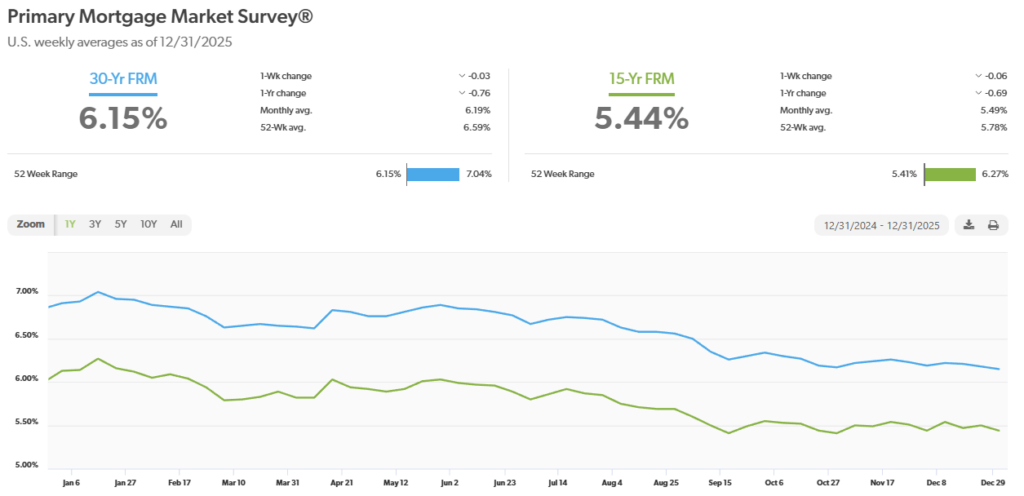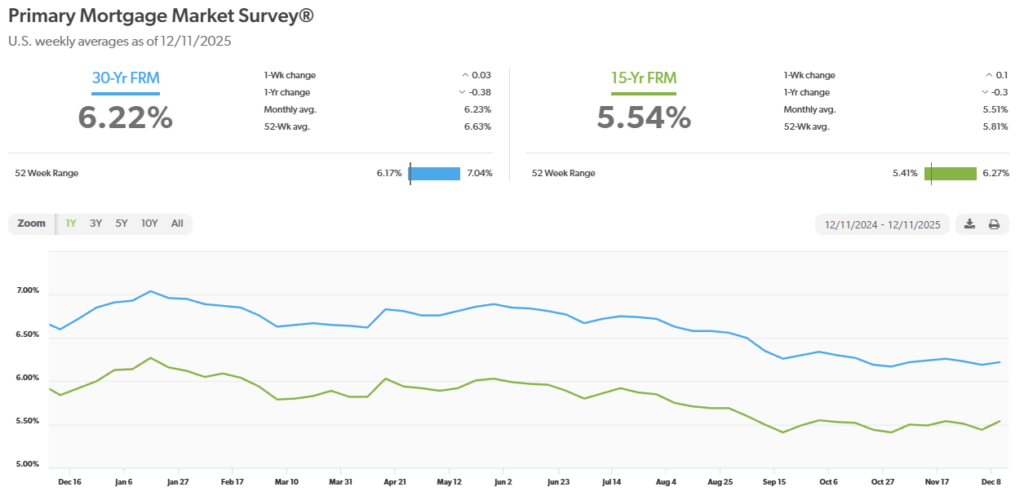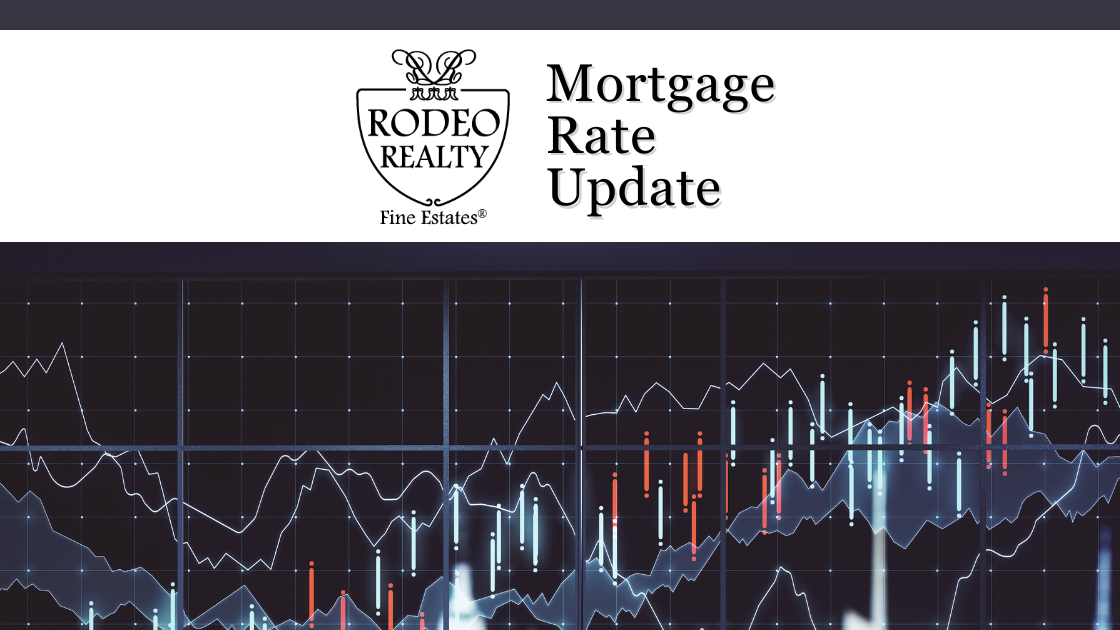| Stocks surged and Stock markets hit record highs in 2025 – All three indexes hit record highs in 2025 but closed the year slightly off their record highs. AI and robust economic growth fueled the rise in stock prices. The Dow Jones Industrial Average ended the year at 48,063.29, up 13% from 42,544.72 on December 31, 2024. The S&P 500 closed the year at 6,845.50, up 16.4% from 5,881.63 on December 31, 2024. The NASDAQ closed at 23,241.99, up 20.4% from 19,310.79 at the end of 2024. GDP surged in the third quarter of 2025 – The U.S. Gross Domestic Product (GDP), the broadest measure of goods and services in the economy, grew at a staggering 4.3% annualized rate in the third quarter of 2025. Earlier in the year, some economists had predicted that the economy was stalling and that a recession could be coming. The pickup in GDP has demonstrated that the economy has remained strong. This was one of the factors that propelled the stock markets this year.
The graph below shows the GDP rate over the past three years
U.S. Treasury Bond Yields – Treasury bond yields ended the year with short-term yields lower and long-term about the same as they were at the beginning of the year – The 10-year U.S. Treasury bond yield closed the year at 4.18%, down from 4.58% on December 31, 2024. The 30-year treasury yield ended the year at 4.84%, up from 4.78% on Dec. 31, 2024. We watch bond yields because mortgage rates often follow Treasury bond yields. Mortgage rates dropped in 2025 – Experts expect them to drop further in 2026 –The Freddie Mac Primary Mortgage Survey reported that mortgage rates for the most popular loan products as of December 31, 2025, were as follows: The 30-year fixed mortgage rate was 6.15%, down from 6.85% on December 26, 2024. The 15-year fixed was 5.44%, down from 6% on December 26, 2024. The graph below shows the trajectory of mortgage rates over the past year. Inflation – We watch inflation because mortgage interest rates are tied to inflation. The higher the inflation rate, the higher the mortgage rates are. As inflation cools, mortgage rates drop. While we look at many different inflation reports, we have less data this year than we normally have because key indexes have not been released due to the government shutdown. One report, the Consumer Price Index (CPI) for November, was released. It showed that consumer prices rose 2.7% from one year ago in November. While still far from the Fed’s 2% annual target, it was much lower than the 3.1% that economists polled expected. The CPI rate peaked at 9.1% in June 2022 and worked its way down to 2.3% in April. Unfortunately, the CPI rate began to increase from there and peaked at 3% in September, which economists attribute to tariff costs being passed on to consumers, before dropping to 2.7% in November. The core CPI rate, which excludes volatile food and energy prices, rose 2.6% from one year ago, also below economists’ expectations. This gave hope to investors that inflation may be cooling enough for the Fed to continue to lower rates. The Fed’s favorite measure of inflation is the Personal Consumption Expenditure Index (PCE).Unfortunately, due to the shutdown, the October and November numbers are still being tabulated and are scheduled for release with the December figures at the end of January. For September, it showed that headline PCE rose 0.3% in September from August. That was in line with economists’ expectations. On an annual basis, PCE rose 2.7% from one year earlier, below the 2.8% expected. Core PCE, which does not include food and energy prices because those tend to be more volatile, increased 0.2% month-over-month in September. On an annual basis, it was up 2.8% from one year earlier. That was below the 2.9% economists expected.
November home sales – The California Association of Realtors and the National Association of Realtors release home sales data on the third week of each month for the previous month. Here is the November 2025 home sales recap. You can run a report on your city or zip code with the same data at RodeoRe.com U.S. existing-home sales – November 2025 – The National Association of Realtorsreported that existing-home sales totaled 4.13 million units on a seasonally adjusted annualized rate in November, up 0.5% from the number of homes sold in October and down 1% from the number of homes sold last November. The median price paid for a home sold in the U.S. in November was $409,200, down from $415,200 in October, but up 1.2% from $404,400 one year ago. There was a 4.2-month supply of homes for sale in November, up from a 3.8-month supply last November. First-time buyers accounted for 30% of all sales, up from 30% last month. Investors and second-home purchases accounted for 18% of all sales, down from 15% in August. All cashpurchases accounted for 27% of all sales, up from 30% last month. Foreclosures and short sales accounted for 2% of all sales. California existing-home sales – The California Association of Realtors reported that existing-home sales totaled 287,940 on an annualized basis in November, up 1.9% from 285,590 in October. Year-over-year sales were up 2.6% from a revised 280,530 annualized home sales last November. The statewide median price paid for a home was $852,680 in November, down 3.9% from 886,960 in October. Year-over-year, the median price was almost unchanged from $852,880 last November. The unsold inventory index showed that there was a 3.1-month supply of homes for sale in October. These numbers are a little deceiving. Prices have dropped more than the median price indicates. The median price is the mid-point of all homes sold. Basically, it’s the point where one half of the homes sold for more and one half of the homes sold for less. Usually, the median price is a good indicator of prices across the board. There are times when conditions impact that. This is one of those times. With stock market values at all-time highs, which they were in October, people who invested in the stock market are flusher than people who are not. Additionally, many of the factors that impact people’s ability and desire to buy a home affect people more in the lower income range than they affect people in higher income ranges. That’s happening now. Sales are down in all price ranges compared to any time prior to interest rates rising in mid-2022, but sales in the lower price ranges as a percentage of all sales are fewer than we would normally see, as those people are more impacted by inflation, don’t have stocks, etc. The graph below shows CAR sales data by county for Southern California. |
Mortgage Rate Update | December 31, 2025
Mortgage rates – Every Thursday, Freddie Mac publishes interest rates based on a survey of mortgage lenders throughout the week. The Freddie Mac Primary Mortgage Survey reported that mortgage rates for the most popular loan products as of December 31, 2025 were as follows:
The 30-year fixed mortgage rate was 6.15%, down slightly from 6.18% last week. The 15-year fixed was 5.44%, down from 5.5% last week.
The graph below shows the trajectory of mortgage rates over the past year.
Mortgage Rate Update | December 24, 2025
Mortgage rates – Every Thursday, Freddie Mac publishes interest rates based on a survey of mortgage lenders throughout the week. The Freddie Mac Primary Mortgage Survey reported that mortgage rates for the most popular loan products as of December 24, 2025 were as follows:
The 30-year fixed mortgage rate was 6.18%, down slightly from 6.21% last week. The 15-year fixed was 5.5%, up slightly from 5.47% last week.
The graph below shows the trajectory of mortgage rates over the past year.
Economic Update | Ending December 20, 2025
Inflation cooled in November – On Thursday the government released the Consumer Price Index (CPI) for November. It showed that consumer prices rose 2.7% from one year ago in November. While still far from the Fed’s 2% annual target it was much lower that the 3.1% that economists polled expected. The core CPI rate, which excludes volatile food and energy prices rose 2.6% from one year ago, also below economists’ expectations. This gave hope to investors that inflation may be cooling enough for the Fed to continue to lower rates.
November jobs report shows some weakness in the labor market – The Bureau of Labor and Statistics released the November jobs report on Wednesday. Usually, jobs reports are released on the first Friday of each month, but the October and November reports were delayed until Wednesday due to the government shutdown that ended in November. It showed that U.S. employers added just 64,000 jobs in November and that 105,000 jobs were lost in October. The unemployment rate increased to 4.6% in November, up from 4.4% in September, its highest level in four years.
Stock Markets – The Dow Jones Industrial Average closed the week at 48,134.89, down 0.7% from 48,458.05 last week. Year-to-date, it is up 8.1% from 44,544.66 on December 31, 2024. The S&P 500 closed the week at 6,834.50, up 0.1% from 6,827.41 last week. Year-to-date, the S&P is up 13.1% from 6,040.53 on December 31, 2024. The Nasdaq closed the week at 23,303.62, up 0.5% from 23,195.17 last week. Year-to-date, it is up 18.7% from 19,627.44 on December 31, 2024.
U.S. Treasury bond yields – The 10-year treasury bond closed the week yielding 4.16%, down slightly from 4.19% last week. The 30-year treasury bond yield ended the week at 4.82%, down slightly from 4.85% last week. We watch bond yields because mortgage rates follow bond yields.
Mortgage rates – Every Thursday, Freddie Mac publishes interest rates based on a survey of mortgage lenders throughout the week. The Freddie Mac Primary Mortgage Survey reported that mortgage rates for the most popular loan products as of December 18, 2025, were as follows: The 30-year fixed mortgage rate was 6.21%, nearly unchanged from 6.22% last week. The 15-year fixed was 5.47%, down from 5.54% last week. The graph below shows the trajectory of mortgage rates over the past year.
The graph below shows the trajectory of mortgage rates over the past year.

November home sales – The California Association of Realtors and the National Association of Real Estate release home sales data on the third week of each month for the previous month. Here is the November 2025 home sales recap. You can run a report on your city or zip code with the same data at RodeoRe.com
U.S. existing-home sales – November 2025 – The National Association of Realtors reported that existing-home sales totaled 4.13 million units on a seasonally adjusted annualized rate in November, up 0.5% from the number of homes sold in October and down 1% from the number of homes sold last November. The median price paid for a home sold in the U.S. in November was $409,200, down from $415,200 in October, but up 1.2% from $404,400 one year ago. There was a 4.2-month supply of homes for sale in November, up from a 3.8-month supply last November. First-time buyers accounted for 30% of all sales, up from 30% last month. Investors and second-home purchases accounted for 18%of all sales, down from 15% in August. All cash purchases accounted for 27% of all sales, up from 30% last month. Foreclosures and short sales accounted for 2% of all sales
California existing-home sales – The California Association of Realtors reported that existing-home sales totaled 287,940 on an annualized basis in November, up 1.9% from 285,590 in October. Year-over-year sales were up 2.6% from a revised 280,530 annualized home sales last November. The statewide median price paid for a home in was $852,680 in November, down 3.9% from 886,960 in October. Year-over-year the median price was almost unchanged from $852,880 last November. The unsold inventory index showed that there was a 3.1-month supply of homes for sale in October. These numbers ae a little deceiving. Prices have dropped more than the median price indicates. The median price is the mid-point of all homes sold. Basically, it’s the point where one half of the homes sold for more and one half of the homes sold for less. Usually, the median price is a good indicator of prices across the board. There are times when conditions impact that. This is one of those times. With stock market values at all-time highs, which they were in October, people invested in the stock market are flusher than people that are not. Additionally, many of the factors that impact people’s ability and desire to buy a home affect people more in the lower income range than they affect people in higher income ranges. That’s happening now. Sales are down in all price ranges compared to any time prior to interest rates rising in mid-2022, but sales in the lower price ranges as a percentage of all sales are fewer than we would normally see as those people are more impacted by inflation, don’t have stocks, etc.
The graph below shows CAR sales data by county for Southern California.

Have a Great Weekend!
Mortgage Rate Update | December 18, 2025
Mortgage rates – Every Thursday, Freddie Mac publishes interest rates based on a survey of mortgage lenders throughout the week. The Freddie Mac Primary Mortgage Survey reported that mortgage rates for the most popular loan products as of December 18, 2025 were as follows:
The 30-year fixed mortgage rate was 6.21%, nearly unchanged from 6.22% last week. The 15-year fixed was 5.47%, down from 5.54% last week.
The graph below shows the trajectory of mortgage rates over the past year.
Economic Update | Week Ending December 12, 2025
The Federal Reserve cut rates again this week – The Fed cut its key interest rates at the conclusion of its policy meeting on Wednesday. The 1/4% rate cut, marked its third meeting in a row that ended with a 1/4% drop, following no cuts in the first three quarters of 2025. That brings the Federal Funds rate to 3.5%-3.75%. That’s down from 4.25%-4.5% at the start of 2025. The Fed Funds rate peaked at 5.25%-5.5% in 2024. The Federal Funds Rate is the overnight rates banks pay. It’s the shortest of short-term rates. It directly impacts the prime lending rate which is an index that is commonly used for business loans and lines of credit, and very short term rates. The prime peaked at 8% in 2024 and now stands at 6.75%. Unfortunately, long-term rates do not follow the Federal Funds Rate. Mortgage rates did not drop after the Fed’s rate drop but we do expect them to drop further in 2026.
Economic news next week – Due to the government shutdown, there has not been inflation or jobs reports for October or November. Next Tuesday the Bureau of Labor and Statistics will release the November Jobs and unemployment report. This would usually be released on the first Friday of the month for the previous month. On Wednesday the Consumer Price Index report will be released. On Thursday we will get the retail sales report. Fed officials , economists, and investors are eagerly awaiting this data. We will know a lot more about the state of the economy, unemployment rate, and inflation next week.
Stock Markets – The Dow Jones Industrial Average closed the week at 48,458.05, up 1.1% from 47,945.99 last week. Year-to-date, it is up 8.8% from 44,544.66 on December 31, 2024. The S&P 500 closed the week at 6,827.41, down 0.6% from 6,870.40 last week. Year-to-date, the S&P is up 13% from 6,040.53 on December 31, 2024. The Nasdaq closed the week at 23,195.17, down 1.6% from 23,578.13 last week. Year-to-date, it is up 18.2% from 19,627.44 on December 31, 2024.
U.S. Treasury bond yields – The 10-year treasury bond closed the week yielding 4.19%, up from 4.14% last week. The 30-year treasury bond yield ended the week at 4.85%, up from 4.79% last week. We watch bond yields because mortgage rates follow bond yields.
Mortgage rates – Every Thursday, Freddie Mac publishes interest rates based on a survey of mortgage lenders throughout the week. The Freddie Mac Primary Mortgage Survey reported that mortgage rates for the most popular loan products as of December 11, 2025 were as follows: The 30-year fixed mortgage rate was 6.22%, up slightly from 6.19% last week. The 15-year fixed was 5.54%, up from 5.44% last week.
The graph below shows the trajectory of mortgage rates over the past year.
 Have a Great Weekend!
Have a Great Weekend!
Mortgage Rate Update | December 11, 2025
Mortgage rates – Every Thursday, Freddie Mac publishes interest rates based on a survey of mortgage lenders throughout the week. The Freddie Mac Primary Mortgage Survey reported that mortgage rates for the most popular loan products as of December 11, 2025 were as follows:
The 30-year fixed mortgage rate was 6.22%, up slightly from 6.19% last week. The 15-year fixed was 5.54%, up from 5.44% last week.
The graph below shows the trajectory of mortgage rates over the past year.
Economic Update | Week Ending December 6, 2025
Key inflation report comes in slightly better than forecasted – Due to the government shutdown there has been very limited data on the state of the economy. The data we have has been coming in later than usual. On Friday, the Bureau of Labor and Statics released the Personal Consumption Expenditure Index (PCE) for September, the Fed’s favorite gauge of inflation. It showed that headline PCE rose 0.3% in September from August. That was in line with economists’ expectations. On an annual basis, PCE rose 2.7% from September 2024, below the 2.8% expected. Core PCE, which does not include food and energy prices because those tend to be more volatile, increased 0.2% month-over-month in September. On an annual basis, it was up 2.8% from one year earlier. That was below the 2.9% economists expected. The BLS also announced that the November PCE report will be released as previously scheduled on December 22, 2025. There will not be an October report this year because the people who do the surveys to gather the data for the reports were furloughed due to the shutdown. They may give some information from October, but it will not be a full report. The September surveys were done before the shutdown. That’s why they had the data to formulate that report, but they will never have the data for an October report. It is odd to be talking about September inflation data in December. Investors are uncertain about the state of the economy, job market, inflation, retail sales, etc., because the data is not current. It looks like the government will have caught up by the end of the month.
Stock Markets – The Dow Jones Industrial Average closed the week at 47,954.99, up 0.5% from 47,716.42 last week. Year-to-date, it is up 7.7% from 44,544.66 on December 31, 2024. The S&P 500 closed the week at 6,870.40, up 0.3% from 6,849.09 last week. Year-to-date, the S&P is up 13.7% from 6,040.53 on December 31, 2024. The Nasdaq closed the week at 23,578.13, up 0.9% from 23,365.69 last week. Year-to-date, it is up 20.1% from 19,627.44 on December 31, 2024.
U.S. Treasury bond yields – The 10-year treasury bond closed the week yielding 4.14%, up from 4.02% last week. The 30-year treasury bond yield ended the week at 4.79% up from 4.67% last week. We watch bond yields because mortgage rates follow bond yields.
Mortgage rates – Every Thursday, Freddie Mac publishes interest rates based on a survey of mortgage lenders throughout the week. The Freddie Mac Primary Mortgage Survey reported that mortgage rates for the most popular loan products as of December 4, 2025, were as follows: The 30-year fixed mortgage rate was 6.19%, down from 6.23% last week. The 15-year fixed was 5.44%, down from 5.51% last week.
The graph below shows the trajectory of mortgage rates over the past year.

Have a Great Weekend!
Mortgage Rate Update | December 4, 2025
Mortgage rates – Every Thursday, Freddie Mac publishes interest rates based on a survey of mortgage lenders throughout the week. The Freddie Mac Primary Mortgage Survey reported that mortgage rates for the most popular loan products as of December 4, 2025 were as follows:
The 30-year fixed mortgage rate was 6.19%, down from 6.23% last week. The 15-year fixed was 5.44%, down from 5.51% last week.
The graph below shows the trajectory of mortgage rates over the past year.




















